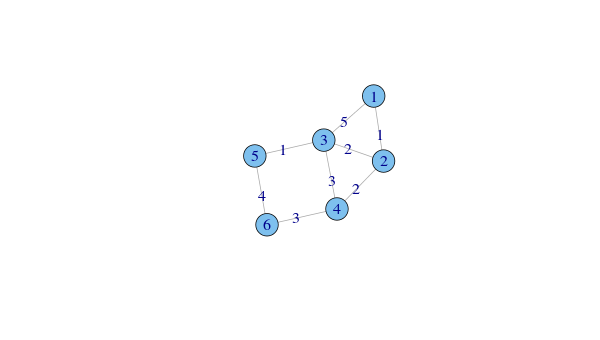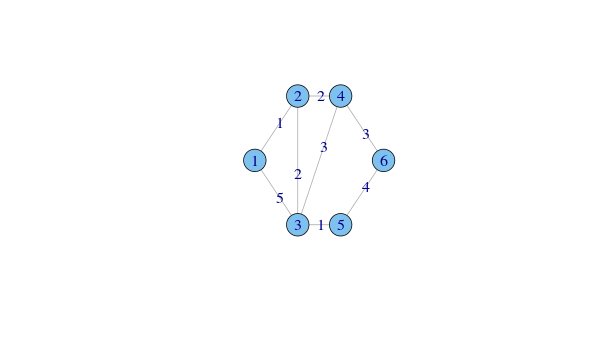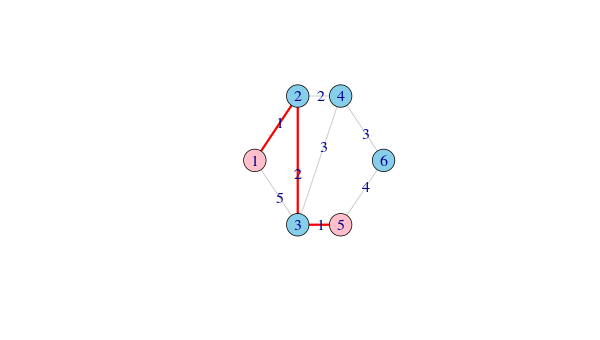問題解決の数理 第4章 ネットワーク計画法1
線形計画問題として解く
最小化
$$\begin{aligned} &z=x_{12}+x_{21}+5x_{13}+5x_{31}+2x_{23}+2x_{32}+2x_{24}+2x_{42}\\ &+3x_{34}+3x_{43}+x_{35}+x_{53}+3x_{46}+3x_{64}+4x_{56}+4x_{65} \end{aligned}$$制約条件
$$\begin{aligned} &x_{12}-x_{21}+x_{13}-x_{31}+0x_{23}+0x_{32}+0x_{24}+0x_{42}\\ &+0x_{34}+0x_{43}+0x_{35}+0x_{53}+0x_{46}+0x_{64}+0x_{56}+0x_{65}=1\\ &0x_{12}+0x_{21}+0x_{13}+0x_{31}+0x_{23}+0x_{32}+0x_{24}+0x_{42}\\ &+0x_{34}+0x_{43}-x_{35}+x_{53}+0x_{46}+0x_{64}+x_{56}-x_{65}=-1\\ &-x_{12}+x_{21}+0x_{13}+0x_{31}+x_{23}-x_{32}+x_{24}-x_{42}\\ &+0x_{34}+0x_{43}+0x_{35}+0x_{53}+0x_{46}+0x_{64}+0x_{56}+0x_{65}=0\\ &0x_{12}+0x_{21}-x_{13}+x_{31}-x_{23}+x_{32}+0x_{24}+0x_{42}\\ &+x_{34}-x_{43}+x_{35}-x_{53}+0x_{46}+0x_{64}+0x_{56}+0x_{65}=0\\ &0x_{12}+0x_{21}+0x_{13}+0x_{31}+0x_{23}+0x_{32}-x_{24}+x_{42}\\ &-x_{34}+x_{43}+0x_{35}+0x_{53}+x_{46}-x_{64}+0x_{56}+0x_{65}=0\\ &0x_{12}+0x_{21}+0x_{13}+0x_{31}+0x_{23}+0x_{32}+0x_{24}+0x_{42}\\ &+0x_{34}+0x_{43}+0x_{35}+0x_{53}-x_{46}+x_{64}-x_{56}+x_{65}=0\\ \end{aligned}$$$$x_{ij}\geq0 for (i,j) \in E$$
|
|
Results of Linear Programming / Linear Optimization
Objective function (Minimum): 4
Iterations in phase 1: 3
Iterations in phase 2: 3
Solution
opt
1 1 1->2
2 0
3 0
4 0
5 1 2->3
6 0
7 0
8 0
9 0
10 0
11 1 3->5
12 0
13 0
14 0
15 0
16 0
Basic Variables
opt
1 1
5 1
11 1
S 1 0
S 5 0
S 6 0
Constraints
actual dir bvec free dual dual.reg
1 1 <= 1 0 0 NA
2 -1 <= -1 0 4 Inf
3 0 <= 0 0 1 Inf
4 0 <= 0 0 3 Inf
5 0 <= 0 0 0 NA
6 0 <= 0 0 0 NA
All Variables (including slack variables)
opt cvec min.c max.c marg marg.reg
1 1 1 -2 2 NA NA
2 0 1 99 77 2 Inf
3 0 5 99 77 2 1
4 0 5 99 77 8 Inf
5 1 2 -5 4 NA NA
6 0 2 99 77 4 Inf
7 0 2 99 77 3 Inf
8 0 2 99 77 1 1
9 0 3 99 77 6 Inf
10 0 3 99 77 0 1
11 1 1 -3 Inf NA NA
12 0 1 99 77 2 Inf
13 0 3 99 77 3 Inf
14 0 3 99 77 3 Inf
15 0 4 99 77 8 Inf
16 0 4 99 77 0 1
S 1 0 0 -1 1 0 NA
S 2 0 0 -4 Inf 4 Inf
S 3 0 0 -1 Inf 1 Inf
S 4 0 0 -3 Inf 3 Inf
S 5 0 0 -3 1 0 NA
S 6 0 0 -3 3 0 NA
igraphパッケージを使う
|
|

|
|

|
|
